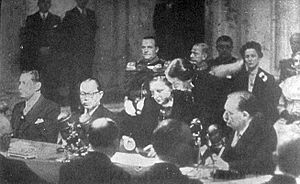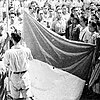ഇന്തോനേഷ്യൻ ദേശീയ വിപ്ലവം
| ഇന്തോനേഷ്യൻ ദേശീയ വിപ്ലവം Perang Kemerdekaan Indonesia | |||||||
|---|---|---|---|---|---|---|---|
| ഏഷ്യയുടെയും ശീതയുദ്ധത്തിന്റെയും അപകോളനീകരണം ഭാഗം | |||||||
 The ഡച്ച് രാജ്ഞി ജൂലിയാന ഹേഗ് ലെ യുണൈറ്റഡ് സ്റ്റേറ്റ്സ് ഓഫ് ഇന്തോനേഷ്യയിലേക്ക് പരമാധികാരം കൈമാറുന്ന രേഖയിൽ ഒപ്പിടുന്നു 27 ഡിസംബർ 1949 | |||||||
| |||||||
| യുദ്ധത്തിൽ ഏർപ്പെട്ടിരിക്കുന്നവർ | |||||||
|
| ||||||
| പടനായകരും മറ്റു നേതാക്കളും | |||||||
| ശക്തി | |||||||
| Republican Army: 195,000 Pemuda: Estimated 160,000 Former Imperial Japanese Army volunteers: 3,000 British Indian Army defectors: 600 | Royal Dutch Army: 20,000 (initial) - 180,000 (peak) Royal Dutch East Indies Army: 60,000 British: 30,000+ (peak)[4] | ||||||
| നാശനഷ്ടങ്ങൾ | |||||||
| 45,000 to 100,000 armed Indonesian casualties | 980 British military deaths[5] 4,585 Dutch military deaths[6] | ||||||
| 97,421 civilian deaths by the hands of Indonesian and Dutch troops[7] | |||||||
Part of a series on the |
|---|
| Indonesia പ്രദേശത്തിന്റെ ചരിത്രം |
   |
| Timeline |
റിപ്പബ്ലിക് ഓഫ് ഇന്തോനേഷ്യയും ഡച്ച് സാമ്രാജ്യവും തമ്മിലുള്ള സായുധ സംഘട്ടനവും നയതന്ത്ര പോരാട്ടവും കുടിയേറ്റത്തിനുശേഷം ഇന്തോനേഷ്യയിലെ യുദ്ധാനന്തര ആഭ്യന്തര സാമൂഹിക വിപ്ലവവുമായിരുന്നു ഇന്തോനേഷ്യൻ ദേശീയ വിപ്ലവം, അല്ലെങ്കിൽ ഇന്തോനേഷ്യൻ സ്വാതന്ത്ര്യയുദ്ധം (ഇന്തോനേഷ്യൻ: പെറാംഗ് കെമെർഡെകാൻ ഇന്തോനേഷ്യ; ഡച്ച്: ഇന്തോനെസിഷെ ഒനാഫാൻകെലിജ്ഖൈഡ്സൂർലോഗ്). 1945-ൽ ഇന്തോനേഷ്യയുടെ സ്വാതന്ത്ര്യ പ്രഖ്യാപനത്തിനും 1949 അവസാനത്തോടെ ഇന്തോനേഷ്യയുടെ സ്വാതന്ത്ര്യത്തെ നെതർലാൻഡ്സ് അംഗീകരിക്കുന്നതിനും ഇടയിലായിരുന്നു ഈ വിപ്ലവം നടന്നത്.
നാലുവർഷത്തെ പോരാട്ടത്തിൽ ഇടയ്ക്കിടെ രക്തരൂക്ഷിതമായ സായുധ പോരാട്ടം, ആഭ്യന്തര ഇന്തോനേഷ്യൻ രാഷ്ട്രീയ, സാമുദായിക പ്രക്ഷോഭങ്ങൾ, രണ്ട് പ്രധാന അന്താരാഷ്ട്ര നയതന്ത്ര ഇടപെടലുകൾ എന്നിവ ഉൾപ്പെടുന്നു. ജാവയിലെയും സുമാത്രയിലെയും ജനാധിപത്യപരമായ പ്രദേശങ്ങളിലെ പ്രധാന പട്ടണങ്ങളും നഗരങ്ങളും വ്യാവസായിക സ്വത്തുക്കളും നിയന്ത്രിക്കാൻ ഡച്ച് സൈനിക സേനയ്ക്ക് (കൂടാതെ, കുറച്ചുകാലത്തേക്ക്, രണ്ടാം ലോക മഹായുദ്ധത്തിന്റെ സഖ്യകക്ഷികൾക്കും) കഴിഞ്ഞെങ്കിലും ഗ്രാമപ്രദേശങ്ങളെ നിയന്ത്രിക്കാൻ കഴിഞ്ഞില്ല. 1949 ആയപ്പോഴേക്കും നെതർലൻഡിന്മേലുള്ള അന്താരാഷ്ട്ര സമ്മർദ്ദവും ഭാഗിക സൈനിക സ്തംഭനാവസ്ഥയും ഇന്തോനേഷ്യൻ സ്വാതന്ത്ര്യത്തെ അംഗീകരിച്ചു.[8]
നെതർലാൻഡ്സ് ന്യൂ ഗിനിയ ഒഴികെ വിപ്ലവം ഡച്ച് ഈസ്റ്റ് ഇൻഡീസിന്റെ കോളനി ഭരണത്തിന്റെ അന്ത്യം കുറിച്ചു. വംശീയ ജാതികളെ ഗണ്യമായി മാറ്റിമറിക്കുകയും പ്രാദേശിക ഭരണാധികാരികളിൽ (രാജ) അധികാരം കുറയ്ക്കുകയും ചെയ്തു. വാണിജ്യത്തിൽ വലിയൊരു പങ്ക് നേടാൻ കുറച്ച് ഇന്തോനേഷ്യക്കാർക്ക് കഴിഞ്ഞെങ്കിലും ഇത് ഭൂരിപക്ഷം ജനങ്ങളുടെയും സാമ്പത്തികം അല്ലെങ്കിൽ രാഷ്ട്രീയം കാര്യമായി മെച്ചപ്പെടുത്തിയില്ല.
പശ്ചാത്തലം
[തിരുത്തുക]1908 മെയ് മാസത്തിൽ ആരംഭിച്ച ഇന്തോനേഷ്യൻ സ്വാതന്ത്ര്യ സമരം "ദേശീയ ഉണർവിന്റെ ദിനം" ആയി അനുസ്മരിക്കപ്പെടുന്നു.(ഇന്തോനേഷ്യൻ: ഹരി കെബാംകിതൻ നാഷനൽ). ഇന്തോനേഷ്യൻ ദേശീയതയും ഡച്ച് കൊളോണിയലിസത്തിൽ നിന്ന് സ്വാതന്ത്ര്യത്തെ പിന്തുണയ്ക്കുന്ന പ്രസ്ഥാനങ്ങളായ ബുഡി ഉട്ടോമോ, ഇന്തോനേഷ്യൻ നാഷണൽ പാർട്ടി, ബുഡി ഉട്ടോമോ, ഇന്തോനേഷ്യൻ നാഷണൽ പാർട്ടി (പിഎൻഐ), സരേകത്ത് ഇസ്ലാം, ഇന്തോനേഷ്യൻ കമ്മ്യൂണിസ്റ്റ് പാർട്ടി (പി കെ ഐ), എന്നിവ ഇരുപതാം നൂറ്റാണ്ടിന്റെ ആദ്യ പകുതിയിൽ അതിവേഗം വളർന്നു. ഇന്തോനേഷ്യയ്ക്ക് സ്വയംഭരണം ലഭിക്കുമെന്ന പ്രതീക്ഷയിൽ ഡച്ച് ആരംഭിച്ച വോൾക്സ്റാഡിൽ ("പീപ്പിൾസ് കൗൺസിൽ") ചേർന്ന് ബുഡി ഉട്ടോമോ, സരേകത്ത് ഇസ്ലാമും മറ്റുള്ളവരും സഹകരണത്തിന്റെ സമരതന്ത്രങ്ങൾ പിന്തുടർന്നു.[9] ഡച്ച് ഈസ്റ്റ് ഇൻഡീസ് കോളനിയിൽ നിന്ന് സ്വയംഭരണത്തിനുള്ള സ്വാതന്ത്ര്യം ആവശ്യപ്പെട്ട് മറ്റുള്ളവർ നിസ്സഹകരണ തന്ത്രം തിരഞ്ഞെടുത്തു.[10] ഈ നേതാക്കളിൽ ഏറ്റവും ശ്രദ്ധേയരായവർ ഡച്ച് എത്തിക്കൽ പോളിസിയുടെ വിദ്യാഭ്യാസ പരിഷ്കാരങ്ങളിൽ നിന്ന് പ്രയോജനം നേടിയ രണ്ട് വിദ്യാർത്ഥികളായ ദേശീയ നേതാക്കൾ സുകർണോയും മുഹമ്മദ് ഹട്ടയുമായിരുന്നു.
രണ്ടാം ലോകമഹായുദ്ധസമയത്ത് മൂന്നര വർഷക്കാലം ജപ്പാൻ ഇന്തോനേഷ്യ പിടിച്ചടക്കിയത് തുടർന്നുള്ള വിപ്ലവത്തിൽ നിർണായക ഘടകമായിരുന്നു. ജാപ്പനീസ് സൈന്യത്തിനെതിരെ തങ്ങളുടെ കോളനിയെ പ്രതിരോധിക്കാനുള്ള കഴിവ് നെതർലൻഡിന് ഇല്ലായിരുന്നു. അവരുടെ ആദ്യ ആക്രമണത്തിന് മൂന്ന് മാസത്തിനുള്ളിൽ ജപ്പാനീസ് സേന ഡച്ച് ഈസ്റ്റ് ഇൻഡീസ് പിടിച്ചടക്കിയിരുന്നു. ജാവയിലും, ഒരു പരിധിവരെ സുമാത്രയിലും (ഇന്തോനേഷ്യയിലെ രണ്ട് പ്രബലമായ ദ്വീപുകൾ), ജാപ്പനീസ് ദേശീയ വികാരം പ്രചരിപ്പിക്കുകയും പ്രോത്സാഹിപ്പിക്കുകയും ചെയ്തു. ഇന്തോനേഷ്യൻ സ്വാതന്ത്ര്യത്തെ പരോപകാരപരമായ പിന്തുണയേക്കാൾ ജാപ്പനീസ് രാഷ്ട്രീയ നേട്ടത്തിനായിട്ടാണ് ഇത് കൂടുതൽ ചെയ്തതെങ്കിലും, ഈ പിന്തുണ പുതിയ ഇന്തോനേഷ്യൻ സ്ഥാപനങ്ങളെയും (പ്രാദേശിക അയൽസംഘടനകൾ ഉൾപ്പെടെ) സൃഷ്ടിക്കുകയും സുകർനോയെപ്പോലുള്ള ഉന്നത രാഷ്ട്രീയ നേതാക്കളെ സൃഷ്ടിക്കുകയും ചെയ്തു. തുടർന്നുള്ള വിപ്ലവത്തെ പോലെ തന്നെ, ഡച്ചുകാർ സൃഷ്ടിച്ച സാമ്പത്തിക, ഭരണ, രാഷ്ട്രീയ അടിസ്ഥാന സൗകര്യങ്ങൾ ജപ്പാൻകാർ നശിപ്പിക്കുകയും പകരം പുതിയതായി കൊണ്ടുവരികയും ചെയ്തു.[11]
1944 സെപ്റ്റംബർ 7 ന്, ജപ്പാൻകാർക്ക് യുദ്ധം മോശമായിക്കൊണ്ടിരിക്കെ, പ്രധാനമന്ത്രി കൊയ്സോ ഇന്തോനേഷ്യയ്ക്ക് സ്വാതന്ത്ര്യം വാഗ്ദാനം ചെയ്തു. പക്ഷേ തീയതി നിശ്ചയിച്ചിരുന്നില്ല. [12] സുകർനോയെ പിന്തുണയ്ക്കുന്നവരെ സംബന്ധിച്ചിടത്തോളം, ഈ പ്രഖ്യാപനം ജാപ്പനീസുമായുള്ള അദ്ദേഹത്തിന്റെ സഹകരണത്തിന് തെളിവായിട്ടാണ് കാണപ്പെടുന്നത്.[13]
കുറിപ്പുകൾ
[തിരുത്തുക]- ↑ Reid 1974, p. 152.
- ↑ Vickers 2005, p. 115.
- ↑ Friend 2003, p. 38.
- ↑ "The War for Independence: 1945 to 1950". Gimonca. Retrieved 23 September 2015.
- ↑ Kirby 1969, p. 258.
- ↑ 1945-1950ubachsberg.nl.
- ↑ https://www.groene.nl/artikel/wie-telt-de-indonesische-doden
- ↑ Friend 2003, p. 35.
- ↑ Vandenbosch 1931, pp. 1051–106.
- ↑ Kahin 1980, pp. 113–120.
- ↑ Vickers 2005, p. 85.
- ↑ Ricklefs 1991, p. 207.
- ↑ Frederick & Worden 1993.
അവലംബം
[തിരുത്തുക]- "Archived copy". 1945-1950ubachsberg.nl. Archived from the original on 10 നവംബർ 2013. Retrieved 3 സെപ്റ്റംബർ 2013.
{{cite web}}: CS1 maint: archived copy as title (link) - Ashton, Nigel John; Hellema, Duco (2001). Unspoken Allies: Anglo-Dutch Relations Since 1780. Amsterdam University Press. ISBN 978-90-485-0585-2.
- Bidien, Charles (5 December 1945). "Independence the Issue". Far Eastern Survey. 14 (24): 345–348. doi:10.1525/as.1945.14.24.01p17062. JSTOR 3023219.
- Bussemaker, H.Th. (2005). Bersiap! Opstand in het paradijs (in Dutch). Zutphen: Walburg Pers. ISBN 90-5730-366-3.
{{cite book}}: CS1 maint: unrecognized language (link) - Colombijn, Freek & Linblad, J. Thomas (Eds) (2002). Roots of Violence in Indonesia: Contemporary Violence in Historical Perspective. Koninklijk Instituut Voor de Tropen. ISBN 90-6718-188-9.
{{cite book}}: CS1 maint: multiple names: authors list (link) - Cribb, Robert (1986). "A revolution delayed: the Indonesian Republic and the Netherlands Indies, August–November 1945". Australian Journal of Politics and History. 32 (1). The Australian National University. Archived from the original on 2019-12-21. Retrieved 2019-11-22.
- Fenton-Huie, Shirley h. (2005). The Forgotten Ones: Women and Children Under Nippon. (Sydney: Angus and Robertson. ISBN 9780207170775.
- Frederick, Willam H. (1989). Visions and Heat: The Making of the Indonesian Revolution. Athens, Ohio: Ohio University Press. ISBN 0-8214-0906-9.
- Frederick, William H.; Worden, Robert L. (eds) (1993). "The National Revolution, 1945–50". Country Studies, Indonesia. GPO for the Library of Congress.
{{cite web}}:|first2=has generic name (help) - Friend, Theodore (1988). Blue Eyed Enemy: Japan against the West in Java and Luzon, 1942-1945. Princeton University Press. ISBN 978-0-691-05524-4.
- Friend, Theodore (2003). Indonesian Destinies. The Belknap Press of Harvard University Press. ISBN 0-674-01834-6.
- Heren, Patrick (November 2010). "The Death Knell of the British Empire". Standpoint. Archived from the original on 2011-11-04. Retrieved 2 October 2011.
- Jessup, John E. (1989). A Chronology of Conflict and Resolution, 1945-1985. New York: Greenwood Press. ISBN 0-313-24308-5.
- Kahin, George McTurnan (1952). Nationalism and Revolution in Indonesia. Ithaca, New York: Cornell University Press. ISBN 0-8014-9108-8.
- Kahin, George McTurnan (1980). "In Memoriam: Mohammad Hatta (1902–1980)" (PDF). Indonesia. 30 (30). Southeast Asia Program Publications at Cornell University: 113–120. doi:10.2307/3350997. hdl:1813/53609. JSTOR 3350997.
- Kahin, George McTurnan (2000). "Sukarno's Proclamation of Indonesian Independence" (PDF). Indonesia. 69 (69). Ithaca, NY: Cornell Modern Indonesia Project: 1–4. doi:10.2307/3351273. hdl:1813/54189. JSTOR 3351273.
- Kahin, George McTurnan; Audrey Kahin (2003). Southeast Asia: A Testament. London: Routledge Curzon. ISBN 0-415-29975-6.
- Kirby, Woodburn S (1969). War Against Japan, Volume 5: The Surrender of Japan. HMSO. p. 258.
- McMillan, Richard (2005). The British Occupation of Indonesia 1945–1946. Melbourne: Routledge. ISBN 0-415-35551-6.
- Lockwood, Rupert (1975). Black Armada: Australia and the Struggle for Indonesian Independence 1942-49. Australasian Book Society.
- van Mook, H. J. (July 1949). "Indonesia". International Affairs. 25 (3). Royal Institute of International Affairs: 278. JSTOR 3016666.
- Parrott, J. G. A. (October 1975). "Who Killed Brigadier Mallaby?" (PDF). Indonesia. 20 (20). Cornell Modern Indonesia Project: 87–111. doi:10.2307/3350997. hdl:1813/53609. JSTOR 3350997. Retrieved 27 November 2006.
- Pendit, Nyoman S. (1988) [1954]. Bali Berjuang (2nd ed.). Jakarta: Gunung Agung. ISBN 9789799954114.
- Pramoedya Anwar Toer; Koesalah Soebagyo Toer; Ediati Kamil (2005). Kronik Revolusi Indonesia Vol I (1945) (in Indonesian). Kepustakaan Populer Gramedia. ISBN 9789799023292.
{{cite book}}: CS1 maint: unrecognized language (link) - Pramoedya Anwar Toer; Koesalah Soebagyo Toer; Ediati Kamil (2005). Kronik Revolusi Indonesia Vol II (1946) (in Indonesian). Kepustakaan Populer Gramedia. ISBN 9789799023308.
{{cite book}}: CS1 maint: unrecognized language (link) - Pramoedya Anwar Toer; Koesalah Soebagyo Toer; Ediati Kamil (2003). Kronik Revolusi Indonesia Vol III (1947) (in Indonesian). Kepustakaan Populer Gramedia. ISBN 9789799023469.
{{cite book}}: CS1 maint: unrecognized language (link) - Pramoedya Anwar Toer; Koesalah Soebagyo Toer; Ediati Kamil (2014). Kronik Revolusi Indonesia Vol IV (1948) (in Indonesian). Kepustakaan Populer Gramedia. ISBN 9789799106896.
{{cite book}}: CS1 maint: unrecognized language (link) - Reid, Anthony (1974). The Indonesian National Revolution 1945–1950. Melbourne: Longman. ISBN 0-582-71046-4.
- Reid, Anthony (1981). "Indonesia: revolution without socialism". In Jeffrey, Robin (ed.). Asia: the Winning of Independence. Macmillan. pp. 113–162. ISBN 9780333278574.
- Ricklefs, M.C. (1993). A History of Modern Indonesia Since c.1300. San Francisco: Stanford University Press.
- Said, H. Mohammed (1973). "What was the Social Revolution of 1946" in East Sumatra?" (PDF). Indonesia. 15 (April 1973). Ithaca, NY: Cornell Modern Indonesia Project: 145–186.
- Stoler, Ann (1985). Capitalism and Confrontation in Sumatra's Plantation Belt, 1870–1979. New Haven: Yale University Press. ISBN 9780472082193.
- Sukarno; Adams, Cindy (1965). Sukarno: An Autobiography. Bobbs-Merrill.
- Taylor, Jean Gelman (2003). Indonesia: Peoples and History. Yale University Press. p. 325. ISBN 0-300-10518-5.
- Tjandraningsih, Christine T. (19 August 2011). "Indonesians to get book on Japanese freedom fighter". Japan Times. Archived from the original on 2020-01-18. Retrieved 29 October 2018.
- Vandenbosch, Amry (1931). "Nationalism in Netherlands East India". Pacific Affairs. 4 (12). Pacific Affairs, University of British Columbia: 1051–1069. doi:10.2307/2750579. JSTOR 2750579.
- Vickers, Adrian (2005). A History of Modern Indonesia. New York: Cambridge University Press. pp. 85–112. ISBN 0-521-54262-6.
കൂടുതൽ വായനയ്ക്ക്
[തിരുത്തുക]- Anderson, Ben (1972). Java in a Time of Revolution: Occupation and Resistance, 1944–1946. Ithaca, N.Y.: Cornell University Press. ISBN 0-8014-0687-0.
- Cribb, Robert (1991). Gangster and Revolutionaries: The Jakarta People's Militia and the Indonesian Revolution 1945–1949. Sydney, Australia: ASSA Southeast Asian Publications Series – Allen and Unwin. ISBN 0-04-301296-5.
- Drooglever, P. J.; Schouten, M. J. B.; Lohanda, Mona (1999). Guide to the Archives on Relations between the Netherlands and Indonesia 1945–1963. The Hague, Netherlands: ING Research Guide.
- George, Margaret (1980). Australia and the Indonesian Revolution. Melbourne University Press. ISBN 0-522-84209-7.
- Heijboer, Pierre (1979). De Politionele Acties (in Dutch). Haarlem: Fibula-van Dishoeck.
{{cite book}}: CS1 maint: unrecognized language (link) - Holst Pellekaan, R.E. van, I.C. de Regt "Operaties in de Oost: de Koninklijke Marine in de Indische archipel (1945-1951)" (Amsterdam 2003).
- Ide Anak Agug Gde Agung (1996) (translated to English by Linda Owens)From the Formation of the State of East Indonesia Towards the Establishment of the United States of Indonesia Jakarta: Yayasan Obor Indonesia ISBN 979-461-216-2 (Original edition Dari Negara Indonesia Timur ke Republic Indonesia Serikat 1985 Gadjah Mada University Press)
- Jong, Dr. L. de (1988). Het Koninkrijk der Nederlanden in de Tweede Wereldoorlog, deel 12, Sdu, 's-Gravenhage (an authoritative standard text on both the political and military aspects, in Dutch)
- Kahin, Audrey (1995). Regional Dynamics of the Indonesian Revolution. University of Hawaii Press. ISBN 0-8248-0982-3.
- Kahin, George McTurnan (1952) [1951]. "Nationalism and Revolution in Indonesia". Ithaca, NY: Cornell University Press. OCLC 406170.
{{cite journal}}: Cite journal requires|journal=(help) - Kodam VI/Siliwang (1968). Siliwangi dari masa kemasa (in Indonesian). Fakta Mahjuma.
{{cite book}}: CS1 maint: unrecognized language (link) - Lucas, A. (1991). One Soul One Struggle. Region and Revolution in Indonesia. St. Leonards, Australia: Allen & Unwin. ISBN 0-04-442249-0.
- McMillan, Richard (2005). The British Occupation of Indonesia 1945–1946. New York, NY: Routledge. ISBN 0-415-35551-6.
- Payne, Robert (1947). The Revolt In Asia. New York: John Day.
- Poeze, Harry A. (2007). Verguisd en vergeten. Tan Malaka, de linkse beweging en de Indonesische Revolutie 1945–1949. KITLV. p. 2200. ISBN 978-90-6718-258-4.
- Taylor, Alastair M. (1960). Indonesian Independence and the United Nations. London: Stevens & Sons. ASIN B0007ECTIA.
- Yong Mun Cheong (2004). The Indonesian Revolution and the Singapore Connection, 1945–1949. Leiden, Netherlands: KITLV Press. ISBN 90-6718-206-0.
പുറത്തേക്കുള്ള കണ്ണികൾ
[തിരുത്തുക]- Parallel and Divergent Aspects of British Rule in the Raj, French Rule in Indochina, Dutch Rule in the Netherlands East Indies (Indonesia), and American Rule in the Philippines.
- Radio address by Queen Wilhelmina on 7 December 1942.
- Dutch Proposals for Indonesian Settlement 6 November 1945.
- Dutch Proposals for Indonesian Settlement 10 Feb 1946.
- Text of the Linggadjati Agreement 10 Feb 1946.
- The Renville Political Principles 17 January 1948.
- Dutch Queen Signs away an Empire (1950), newsreel on the British Pathé YouTube Channel

